Marc Tyler Nobleman's Blog, page 10
February 6, 2022
Great school parking lot sign on first author trip to NC
I've been to close to 30 states to visit schools or present at conferences, and the latest to join the list is North Carolina. On February 2-3, 2022, I spoke to students at three NC schools (two elementaries and one university).
One of the elementaries, Marshville, has not one but two signs/displays that must be amplified.
One is bedecking a stall door in a bathroom, and it echoes a message I share at the end of my presentations.
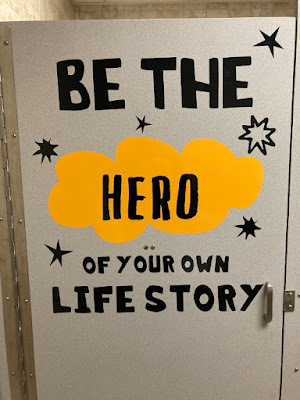
The other is at the exit of the parking lot. No, not the one about left turns.
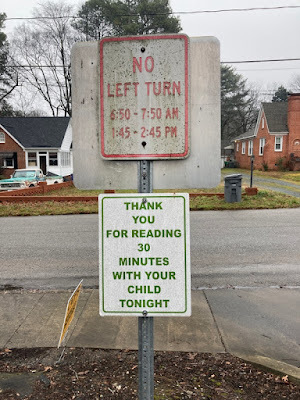
Thank you again to Melanie Keel at Wingate University for organizing this trip!
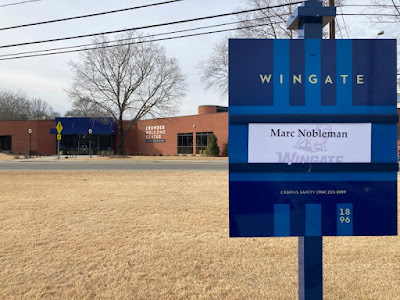
One of the elementaries, Marshville, has not one but two signs/displays that must be amplified.
One is bedecking a stall door in a bathroom, and it echoes a message I share at the end of my presentations.

The other is at the exit of the parking lot. No, not the one about left turns.

Thank you again to Melanie Keel at Wingate University for organizing this trip!

Published on February 06, 2022 20:27
February 3, 2022
German news asking me about Tennessee school board ban of “Maus”
The German news outlet Die Welt (“The World”) interviewed (and overdubbed) me for this short piece about the Tennessee school board banning of Maus.
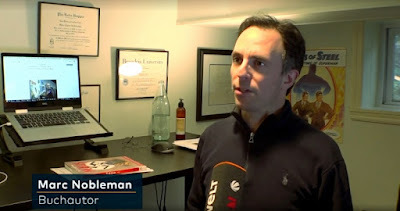
I do not remember exactly what I said, nor do I know which portion they excerpted. If your German, like mine, is rusty, the best I can do as far as a translation: I probably repeated something I already wrote here.

I do not remember exactly what I said, nor do I know which portion they excerpted. If your German, like mine, is rusty, the best I can do as far as a translation: I probably repeated something I already wrote here.
Published on February 03, 2022 04:00
February 1, 2022
Changing a cartoon depicting an Indigenous ceremony
In 2005, the first of my two books called Vocabulary Cartoon of the Day came out, featuring 180 single panel cartoons for grades 4-6. To get the joke, kids must learn the bolded word in each caption.
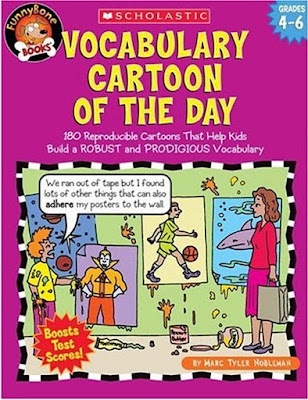
In 2020, my publisher, Scholastic, told me that a reader had contacted them to report a cartoon that he/she/they felt was a “stereotypical representation of Indigenous people.” My editor asked me to replace it with a new cartoon for future printings.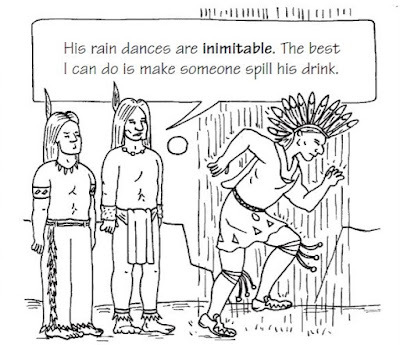
* Please do not repost without a link to this post, for context. *
I have no doubt I referred to photos and images of rain dances to create this cartoon, for two reasons. One, I go to significant lengths to ensure my work is accurate, including art (even when I am not the one illustrating, as with all of my picture books). Two, then and now, I couldn’t even begin to pull from my brain what such a scene should look like.
But in this case, I neglected to save my sources—which is both regrettable and uncharacteristic, since I keep meticulous notes on sources for my writing.
Admitting that glaring lapse, I sought input from tribal chairpeople and organizational directors of Indigenous nations whose customs have included rain dances.
The feedback I got included differing opinions, some with historical frameworks—all tremendously helpful and equally appreciated. I suspect you’ll also find them illuminating. Quoted verbatim:
1)
The cartoon is not acceptable and is disrespectful. Do not incorporate it into your work.—Osage Nation Wahzhazhe Cultural Center
2)
Perhaps the complaining person thought the immediate rain might was disrespectful. The rain dance is done as a spiritual ceremony. I suppose some Indians would say that the head dress does not depict their traditions. It is so with the Potawatomi Nations containing 10 Indian Tribes. All tribes that I know of were long pants, not short pants. Even so, I can’t imagine anyone complaining about a picture cartoon. Also, all Tribes that I know wear long pants, not short pants.
I don’t think it is in good taste to complain about a picture cartoon in a children’s book. I would not do so, but there are “different strokes for different folks” all around the world. —Citizen Potawatomi Nation
3)
Since Rain Dances are really prayer dances, some may have taken exception to a humorous portrayal of a religious ceremony. Personally, I do not find the cartoon offensive, given your intent to demonstrate or illustrate a vocabulary word for educational purposes. People need to lighten up a bit on ethnic outrage. Your cartoon was not intended to offend, and did not.—Citizen Potawatomi Nation [different person than previous]
4)
Insulting.—Osage Nation Historic Preservation Office
5)
I would state that “rainmaking” is an old trope that marginalizes the realities of complex Native science and religion. This perpetuates harmful stereotypes that infantilizes Native ceremony by removing all context of Native ceremonial life and imposes Western concepts of dance as entertainment.
Also, your cartoon depiction of Native dress is not accurate. “Rain Dance” ceremonies were not practiced by the Osage. From your cartoon it seems you are using an amalgam of Plains tribe stereotypes, but the majority of ceremonies of that nature were practiced by indigenous people of the southwest.
Overall, given the criminal lack of basic cultural sensitivity and knowledge of Native history, using any tribal ceremony is a vehicle for children to learn English vocabulary is offensive. The majority of children are not even taught whose land they live on. At most, they would see your work and continue to think of Native peoples as cartoons and their ceremonial life as silly.—Osage Nation Historic Preservation Office [different person than previous]
6)
With greater public awareness of cultural appropriation, and its effects on Indigenous people, we do not endorse the depiction of Cherokee ceremony by non-tribal citizens. Furthermore, upon reviewing your piece, it does not appear to depict Cherokee people, but rather a pan-Indian notion of all “Indians” with feathers and headdress. We cannot verify if you correctly depicted any sort of North American Indigenous “Rain Dance.”
It may have been considered palatable by the general public in the past. However, Indigenous people have been advocating heavily for accurate cultural representation, and ending harmful stereotypes for many years. Today, many long held stereotypes are being dismantled and it appears that is the case with this piece. Going forward, we encourage non-Indigenous people to fully research a culture before attempting to characterize it, and consider the notion that the people of that culture prefer to represent themselves, rather than have a person from a different culture do it for them.—Cherokee Heritage Center
I don’t imagine I’ll be making any more cartoon books, but regardless of the project, now I do my due diligence better than I did with this cartoon.
The replacement:
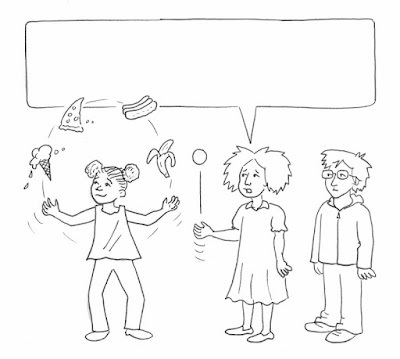 caption: Her juggling skills are inimitable. Obviously I’m just a beginner.
caption: Her juggling skills are inimitable. Obviously I’m just a beginner.
I’ve always (and sometimes explicitly) welcomed readers notifying me about any mistakes or insensitivities in my work. Keep it up, citizen editors!

In 2020, my publisher, Scholastic, told me that a reader had contacted them to report a cartoon that he/she/they felt was a “stereotypical representation of Indigenous people.” My editor asked me to replace it with a new cartoon for future printings.

* Please do not repost without a link to this post, for context. *
I have no doubt I referred to photos and images of rain dances to create this cartoon, for two reasons. One, I go to significant lengths to ensure my work is accurate, including art (even when I am not the one illustrating, as with all of my picture books). Two, then and now, I couldn’t even begin to pull from my brain what such a scene should look like.
But in this case, I neglected to save my sources—which is both regrettable and uncharacteristic, since I keep meticulous notes on sources for my writing.
Admitting that glaring lapse, I sought input from tribal chairpeople and organizational directors of Indigenous nations whose customs have included rain dances.
The feedback I got included differing opinions, some with historical frameworks—all tremendously helpful and equally appreciated. I suspect you’ll also find them illuminating. Quoted verbatim:
1)
The cartoon is not acceptable and is disrespectful. Do not incorporate it into your work.—Osage Nation Wahzhazhe Cultural Center
2)
Perhaps the complaining person thought the immediate rain might was disrespectful. The rain dance is done as a spiritual ceremony. I suppose some Indians would say that the head dress does not depict their traditions. It is so with the Potawatomi Nations containing 10 Indian Tribes. All tribes that I know of were long pants, not short pants. Even so, I can’t imagine anyone complaining about a picture cartoon. Also, all Tribes that I know wear long pants, not short pants.
I don’t think it is in good taste to complain about a picture cartoon in a children’s book. I would not do so, but there are “different strokes for different folks” all around the world. —Citizen Potawatomi Nation
3)
Since Rain Dances are really prayer dances, some may have taken exception to a humorous portrayal of a religious ceremony. Personally, I do not find the cartoon offensive, given your intent to demonstrate or illustrate a vocabulary word for educational purposes. People need to lighten up a bit on ethnic outrage. Your cartoon was not intended to offend, and did not.—Citizen Potawatomi Nation [different person than previous]
4)
Insulting.—Osage Nation Historic Preservation Office
5)
I would state that “rainmaking” is an old trope that marginalizes the realities of complex Native science and religion. This perpetuates harmful stereotypes that infantilizes Native ceremony by removing all context of Native ceremonial life and imposes Western concepts of dance as entertainment.
Also, your cartoon depiction of Native dress is not accurate. “Rain Dance” ceremonies were not practiced by the Osage. From your cartoon it seems you are using an amalgam of Plains tribe stereotypes, but the majority of ceremonies of that nature were practiced by indigenous people of the southwest.
Overall, given the criminal lack of basic cultural sensitivity and knowledge of Native history, using any tribal ceremony is a vehicle for children to learn English vocabulary is offensive. The majority of children are not even taught whose land they live on. At most, they would see your work and continue to think of Native peoples as cartoons and their ceremonial life as silly.—Osage Nation Historic Preservation Office [different person than previous]
6)
With greater public awareness of cultural appropriation, and its effects on Indigenous people, we do not endorse the depiction of Cherokee ceremony by non-tribal citizens. Furthermore, upon reviewing your piece, it does not appear to depict Cherokee people, but rather a pan-Indian notion of all “Indians” with feathers and headdress. We cannot verify if you correctly depicted any sort of North American Indigenous “Rain Dance.”
It may have been considered palatable by the general public in the past. However, Indigenous people have been advocating heavily for accurate cultural representation, and ending harmful stereotypes for many years. Today, many long held stereotypes are being dismantled and it appears that is the case with this piece. Going forward, we encourage non-Indigenous people to fully research a culture before attempting to characterize it, and consider the notion that the people of that culture prefer to represent themselves, rather than have a person from a different culture do it for them.—Cherokee Heritage Center
I don’t imagine I’ll be making any more cartoon books, but regardless of the project, now I do my due diligence better than I did with this cartoon.
The replacement:
 caption: Her juggling skills are inimitable. Obviously I’m just a beginner.
caption: Her juggling skills are inimitable. Obviously I’m just a beginner.I’ve always (and sometimes explicitly) welcomed readers notifying me about any mistakes or insensitivities in my work. Keep it up, citizen editors!
Published on February 01, 2022 18:50
January 31, 2022
My letter to the Tennessee school board that banned “Maus”
News broke on 1/27/22 (International Holocaust Remembrance Day) that the 10-person school board of McMinn County, Tennessee, unanimously banned the Pulitzer Prize-winning graphic memoir Maus by Art Spiegelman because it contains “rough language” and nudity that it considers inappropriate for 8th graders.
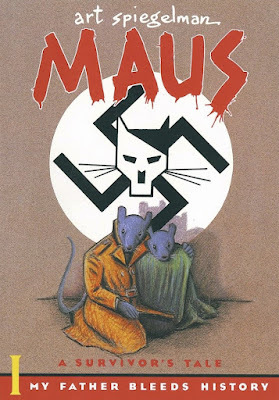
Of course, the book also contains the Holocaust, which calls into question if the reasons the school board have stated are the only reasons.
In any case, banning books was deplorable when the Nazis did it, and it’s deplorable today.
I joined the international chorus of individuals and organizations condemning this decision by contacting Lee Parkison, the director of schools, at lparkison@mcminnschools.com, and each of the board members (one by one) via this form.
I didn’t set out to write an open letter, but sharing is caring:
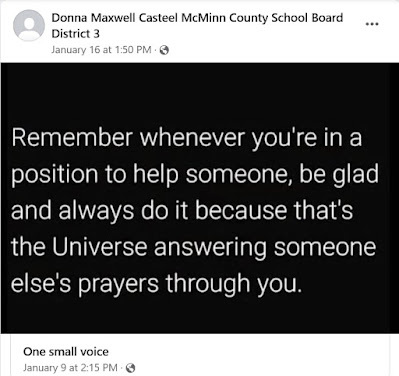
(Donna Casteel is one of the school board members.)
Believe it or not, that is me trying to keep it short.
It seems (as of 2010) that (h/t Gregory Paul Silber at The Beat).
All the more reason to reinstate this book.

Of course, the book also contains the Holocaust, which calls into question if the reasons the school board have stated are the only reasons.
In any case, banning books was deplorable when the Nazis did it, and it’s deplorable today.
I joined the international chorus of individuals and organizations condemning this decision by contacting Lee Parkison, the director of schools, at lparkison@mcminnschools.com, and each of the board members (one by one) via this form.
I didn’t set out to write an open letter, but sharing is caring:
1/27/22
Mr. Parkison and the McMinn County School Board,
“Remember that whenever you’re in a position to help someone, be glad and always do it because that’s the Universe answering someone else’s prayers through you.”
I hope you and your families are well.
I’m a Maryland author of books for young readers. I’ve had the privilege of speaking to kids of all ages/backgrounds in 30+ states (including Tennessee) and a dozen countries.
Therefore, you and I are in the same business: trying to do what’s best for future generations.
But I don’t write to you as a writer. Rather I reach out as a parent, a fellow adult, and a Jew to encourage you to reverse your decision to ban Maus.
No matter where I am, the kids are smarter and more capable than many adults give them credit for. I’m sure you see this in your community.
Maus is a difficult book, yes—which is a reason why it is important.
Hiding unpleasant truths can harm kids more than talk of unpleasantness. Helping them understand those truths equips them for life. If we share only what we consider good, kids will be blindsided when they grow up and realize they were not taught how to handle the bad.
I know you banned this book not because it addresses genocide but because it includes objectionable language and an image of nudity.
We all know that every middle schooler in your district—in every district, throughout history—has already seen nudity and heard curse words. So did we, when we were young. We carried on.
But some middle schoolers may not be aware of the devastating scope of the Holocaust, and may not pay attention if it’s covered in class, and may never hear a word of it at home…but may pick up a graphic novel about it.
If we banned every book that offended someone, we’d ban every book. Like everything in life, America is imperfect, yet despite its problems, it remains a place where freedom of expression is a right. Live and let live.
Read and let read.
Future leaders in your community need this book. Please give them access to it.
Thank you for your time.
P.S. Did you agree with that quotation at the top? It’s from a 1/16/22 Facebook post by Donna Casteel.

(Donna Casteel is one of the school board members.)
Believe it or not, that is me trying to keep it short.
It seems (as of 2010) that (h/t Gregory Paul Silber at The Beat).
All the more reason to reinstate this book.
Published on January 31, 2022 13:25
January 14, 2022
First work flight since March 2020: howdy San Antonio
When I flew back from a school visit in Ohio on 3/13/20, little did I know it would be the last such trip for a while. Like the rest of the world, I was about to enter virtual reality.
I would not present in person again until June 2021, and that was to teach creative writing camps at schools near me—so not my traditional assembly talk (and no flight required, and masked).
My first pandemic assembly was at my daughter’s school in Germany in August 2021. Though I did fly to get there, I’d gone for other reasons and this opportunity came up last minute; plus it was pro bono. In other words, not yet a true return to form (though a huge pleasure). I was on a stage, socially distanced from the audience, and this was during the golden (yet brief) period when vaccinated people felt safe without a mask in certain situations.
My next in-person was in October 2021, but close to home and pro bono. It was my first outdoors school visit. It was at the point when the Delta surge was in the rear view and Omicron had yet to rear its ugly droplet, so I did not wear a mask while presenting (and did not go near the students till I put one on).
My first paid in-person school visit since COVID began was in December 2021, in Delaware (driving distance from me). Boosted, and with Omicron still not a confirmed threat in the U.S., the school allowed me to present without a mask (again, I still kept at least six feet from students).
The first more complete taste of school visit life pre-COVID came this week, when I flew to San Antonio, TX, to present at five elementary schools (four in NISD and one in NBISD). But, of course, changes abounded. Every morning before leaving the hotel, I took a rapid test. Though one of the schools said I did not need to keep my mask on while speaking, and though many students and teachers in some of the schools did not wear masks, I kept my N95 on the whole time (except for the brief Q&A at one school, since I was far from the kids).
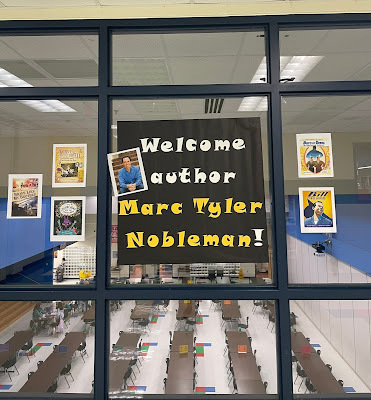
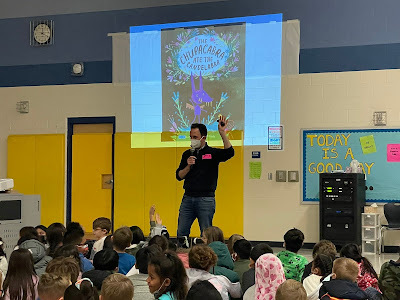
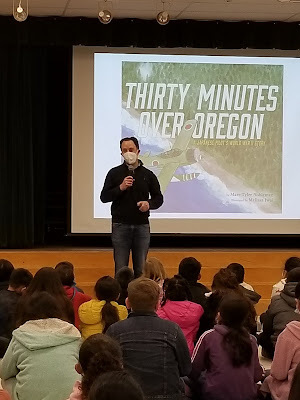
Thank you Tammy, Karen, Angela, Elizabeth, and Michelle for making this possible!
I’ve done virtual talks throughout the pandemic, which involved a learning curve but a welcome one. So while that kept up my muscle memory for presenting, this Texas trip threw me back into the headspace of the logistics of traveling…things you wouldn’t think you’d forget but can become hazy with disuse. Things like arranging a rental car and smart packing for a school visit.
If nature cooperates, I will be flying to speak in North Carolina, Colorado, Nevada, and Michigan before the two-year anniversary of the official start of the pandemic.
Nature…please cooperate. I’ve missed this.
Except the part about renting cars.
I would not present in person again until June 2021, and that was to teach creative writing camps at schools near me—so not my traditional assembly talk (and no flight required, and masked).
My first pandemic assembly was at my daughter’s school in Germany in August 2021. Though I did fly to get there, I’d gone for other reasons and this opportunity came up last minute; plus it was pro bono. In other words, not yet a true return to form (though a huge pleasure). I was on a stage, socially distanced from the audience, and this was during the golden (yet brief) period when vaccinated people felt safe without a mask in certain situations.
My next in-person was in October 2021, but close to home and pro bono. It was my first outdoors school visit. It was at the point when the Delta surge was in the rear view and Omicron had yet to rear its ugly droplet, so I did not wear a mask while presenting (and did not go near the students till I put one on).
My first paid in-person school visit since COVID began was in December 2021, in Delaware (driving distance from me). Boosted, and with Omicron still not a confirmed threat in the U.S., the school allowed me to present without a mask (again, I still kept at least six feet from students).
The first more complete taste of school visit life pre-COVID came this week, when I flew to San Antonio, TX, to present at five elementary schools (four in NISD and one in NBISD). But, of course, changes abounded. Every morning before leaving the hotel, I took a rapid test. Though one of the schools said I did not need to keep my mask on while speaking, and though many students and teachers in some of the schools did not wear masks, I kept my N95 on the whole time (except for the brief Q&A at one school, since I was far from the kids).



Thank you Tammy, Karen, Angela, Elizabeth, and Michelle for making this possible!
I’ve done virtual talks throughout the pandemic, which involved a learning curve but a welcome one. So while that kept up my muscle memory for presenting, this Texas trip threw me back into the headspace of the logistics of traveling…things you wouldn’t think you’d forget but can become hazy with disuse. Things like arranging a rental car and smart packing for a school visit.
If nature cooperates, I will be flying to speak in North Carolina, Colorado, Nevada, and Michigan before the two-year anniversary of the official start of the pandemic.
Nature…please cooperate. I’ve missed this.
Except the part about renting cars.
Published on January 14, 2022 07:05
January 13, 2022
Weirdo nerd hyper obsession
From a Twitter thread mentioning Batman & Bill:

I would’ve said “weirdo geek,” but all interpretations welcome.

I would’ve said “weirdo geek,” but all interpretations welcome.
Published on January 13, 2022 20:50
December 26, 2021
“Race the Drop”—a short comedy film with a twist ending
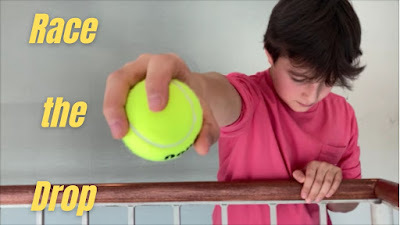
In 1993, while a student at Brandeis University, a spiral staircase on campus gave me the idea for a short film.
I made a four-page storyboard for it and intended to film it in that stairwell, with myself as the lead (only) character.
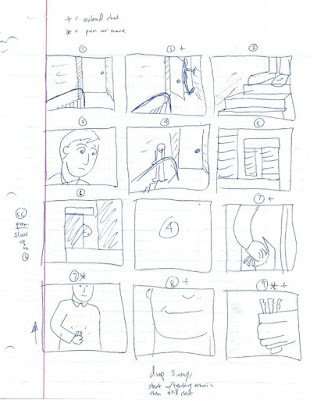 page 1 of 4; note how the original concept was dropping keys, not a ball
page 1 of 4; note how the original concept was dropping keys, not a ballBut I didn’t follow through.
Until 2021.
It took a pandemic to give me the kick to finally make the film, but now I live several states away from that staircase, so starting in October 2020, I spent more than a year on and off as a location scout, trying to find a different one. The stairwell had to meet certain criteria:
4-5 stories (what I feel is the sweet spot for the gag to work)you can see from the top to the bottom (and vice versa)not heavily trafficked (but then, most probably aren’t)
Early in the search, I found what seemed like an ideal location—a school in Baltimore that had closed, so little risk of more than one or two people in the building (a criteria that became critical during COVID-19). But the person in charge said no, multiple times, no explanation.
Fast forward to November 2021, when my son had a soccer tournament far enough from home that we stayed a night in a hotel. Across the parking lot from that hotel was this sight:
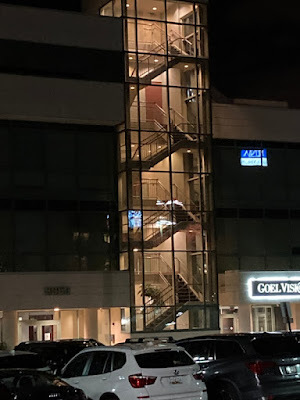
I called the restaurant on the ground floor to ask who managed the building, then contacted the management company. I explained that I was seeking access to the stairwell for 3-4 hours to shoot a short film with my son and two of his friends; I’d be using my iPhone to film and the only other equipment would be a chair and a tennis ball (technically 18 tennis balls). I was worried that liability would be an issue, though I was prepared to sign a waiver.
To my strong surprise, the president of commercial management gave me the green light almost immediately without condition. He suggested we do it on Sunday because no one else would be in the building.
If there’s one thing teens can’t get enough of, it’s waking up at 8 am on a weekend. But my son is a trooper in more ways than one, and so are his two buddies we recruited to be ball boys (more commonly referred to on film sets as the “crew”). We got to work at 9 am; 95 clips and two short breaks later, we wrapped at noon.
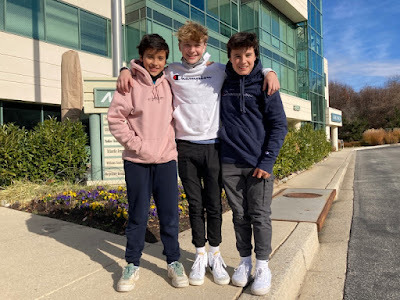
No one broke an ankle, or a window. Craft services was lunch at MOD Pizza.
Of those 95 videos I shot, 36 made it into the 2½-minute film (including end credits). I edited it with Movie Maker, needing almost no special effects (only a couple of slo-mo moments).
I had not titled the idea upon creation, but after the shoot, two came to me: Ball Drop and Race the Drop. As is my tendency, I went with the one that would sound more original. It also sounds more active, a good fit for this fast-paced scene.
Thanks to cooperative kids and a pretty tight concept, if I do say so myself, the final film is strikingly loyal to the storyboard I sketched 28 (!) years ago. I think it benefited from me being behind the camera. As an “actor,” I might’ve gotten in my own way. Plus my son (and his friends) are way more photogenic.
Only after finishing the edit did I realize two things about the film that made me like it even more:
it’s kid-friendlyit’s world-friendly (i.e. it has no dialogue, so no matter what language you speak, you will understand it)
The most grateful of thanks to Mike Klein of WPM Real Estate Management for granting us access to one of your buildings in Columbia, MD.
And now…enjoy the show!
Published on December 26, 2021 16:24
December 10, 2021
20 formative moments from my time in BBYO
I just dropped off my 13-year-old at his first BBYO overnight (and second BBYO event), so it felt like a right time to look back.
From 1987 to 1990, I was a proud member of the Connecticut Valley Region of the B’nai B’rith Youth Organization. It’s a mix of programming: social, community service, education, Judaic, and athletic. (I wasn’t much use for that last category.)
I also wasn’t a natural joiner. For the first half of our first year of high school, Mike, a guy I’d known since second grade and with whom I’d gone through Hebrew school hounded me for months, insisting I’d love it. Eventually I caved, thinking I’d prove him wrong. But soon I would be elected to a chapter board position for my sophomore year, and regional board positions for junior and senior year.
I owe him—and BBYO—a lot. I’m coming up on 50 and still regularly reflect on how in my teenage years, this experience was the most significant factor in my development.
Here are 20 of my most formative BBYO moments (in approximate chronological order). For each, I indicate what I learned; in some cases, it’s more accurate to say what was reinforced. The friends who feature most in these memories are the aforementioned Mike, Seth, Darren, Kevin, and two Matts (B. and S.).
Midnight Madness
This was a scavenger hunt spread across multiple towns in the New Haven, CT, area, so each team of four needed a car.
It took place at night. It was February of my freshman year. It was cold. I had no gloves or hat. I did not yet have my driver’s license (I was 15) nor did I carry a wallet. Of course no one had cell phones.
All of this made it even more distressing when the older boys on our team accidentally stranded Darren and me at a McDonald’s in a rough neighborhood. (They thought we’d left with another team; we were simply in the bathroom.)
After three nerve-racking hours, by chance, another team stopped by that restaurant and rescued us.
Oh, this was my first BBYO event.
I did not tell my parents till much later how wrong it went. Yet also right, or else I wouldn’t have returned for the next event. It’s the only entry on this list for which I have no photos.
WHAT I LEARNED: how to stay calm and be resourceful in a stressful situation.
The Ruach Rap-Up
My region, CVR, had about 14 chapters. Most were either all-male (AZA) or all-female (BBG). My chapter, Ruach, was one of only a couple that were coed. “Ruach” means “spirit” in Hebrew.
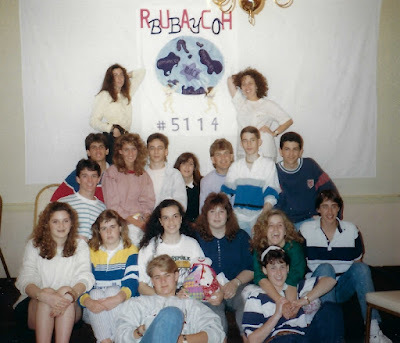
Each chapter would produce a newspaper for distribution at the marquee BBYO event, the regional convention (held twice a year over in a hotel for two nights). These papers would include recaps of events, humor pieces, essays, and other often ribald attempts to entertain the membership. Ours was called The Ruach Rap.
I decided to add a monthly one-page newsletter that would be mailed to each chapter member’s home—meaning it had to be less inappropriate than the newspapers because parents may see it first. I called it The Ruach Rap-Up.
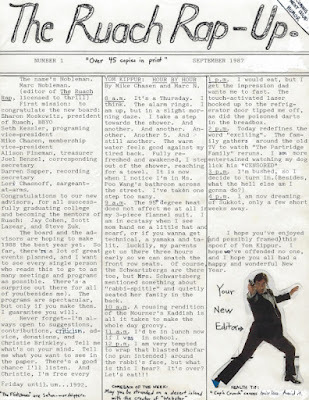
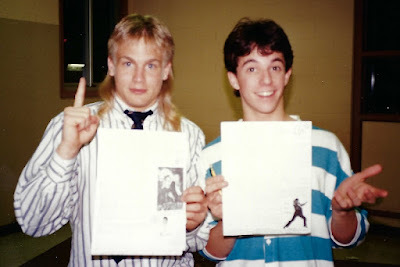 me with Matt S., my editor successor
me with Matt S., my editor successor
WHAT I LEARNED: how to create something new, how to set and keep deadlines, how to delegate, how to edit.
helping the young, the sick, those experiencing homelessness
Self-explanatory!
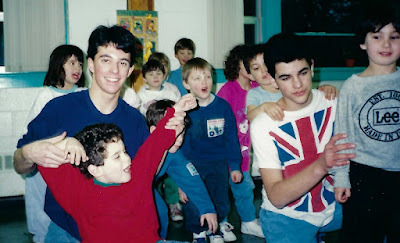
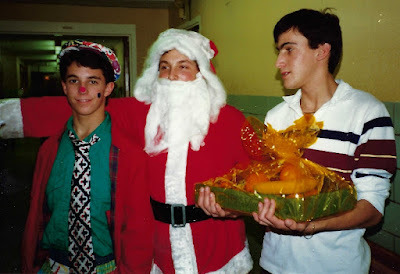 visiting a hospital on Christmas Eve;I have no idea what I am dressed as but it sure is festive
visiting a hospital on Christmas Eve;I have no idea what I am dressed as but it sure is festive
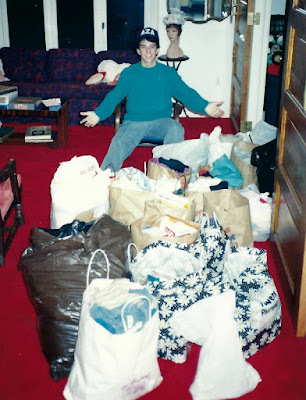 donations we collected for people experiencing homelessness
donations we collected for people experiencing homelessness
WHAT I LEARNED: the imperative to give time to those less fortunate (or less old).
video to welcome new members
When I was still a new member myself, Mike, Seth, Darren, Matt B., and I made a well-intentioned but at times misguided video to introduce BBYO to new members. I don’t remember if we ever actually played it for any new members…but it was a blast to make.
WHAT I LEARNED: how to collaborate/compromise, a wee bit about film production.
“Bad” parody
At my second convention (fall of my sophomore year), I was pushed outside of my comfort zone for three minutes…and it changed the course of my life. The one pushing? Mike, the same kid who pushed me to join BBYO. (He was nothing if not consistent.)
Years before the child molestation accusations against Michael Jackson, and months before “Weird Al” Yankovic released the “Bad” parody song “Fat,” I wrote a “Bad” parody called…“Bad.”
In October 1987, I shared it with Mike and other friends at a chapter meeting. The next month, at fall convention, Mike urged me to sign up to sing it during the Saturday night talent show. As I did when he pushed me to try BBYO, I resisted at first. Then he said he and our other good friends would support me as “backup dancers.” (Never mind that most of them couldn’t dance.)
So I signed. And I sang. But I was so nervous that I sat the whole time. To my surprise (and relief), the audience loved it.
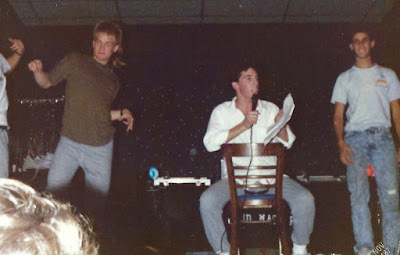
I ended up singing it publicly maybe a dozen more times over the next three years—at Sweet 16 parties (by request, for the video), at other conventions, even at my high school senior picnic. (Keep in mind my classmates had no idea that my geeky friends and I were cool every weekend in BBYO nor would they have pegged me as the kind of kid who would perform solo in front of a crowd.)
WHAT I LEARNED: how to overcome fear, how to trust a friend in taking a risk.
Beau-Sweetheart
The winter of my sophomore year, the region held its first annual Beau-Sweetheart Dance. We voted on a regional Beau and Sweetheart. Somehow I got on the ballot as the nominee from my chapter…and even more somehow, I won. I believe the criteria was “niceness” and maybe a little bit “cuteness.”
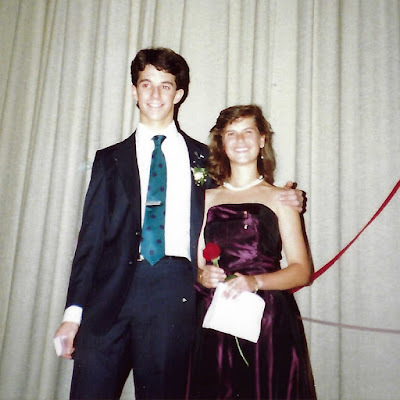
I’m still friends with Leigh, the Sweetheart.
WHAT I LEARNED: how to congratulate people you win against.
The Late Valentine Match-Up
Seth and I created a low-tech matchmaking questionnaire and solicited our region to fill it out. We revealed the matches at spring convention (which took place after Valentine’s Day, hence the name of the endeavor).
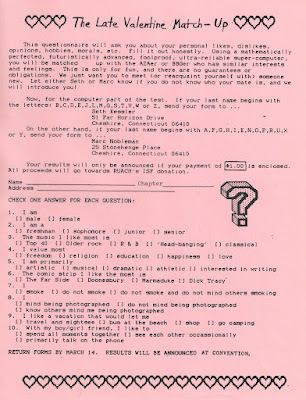
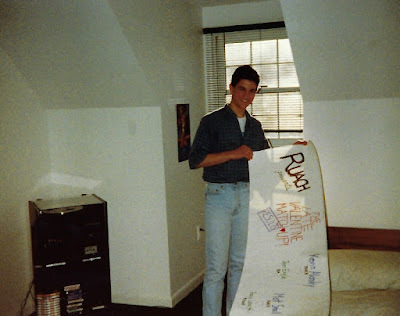 We presented the results on a big banner.
We presented the results on a big banner.
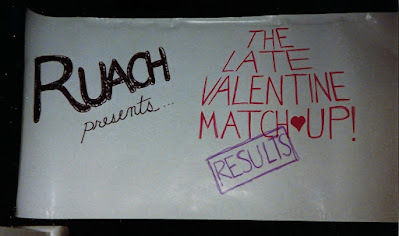
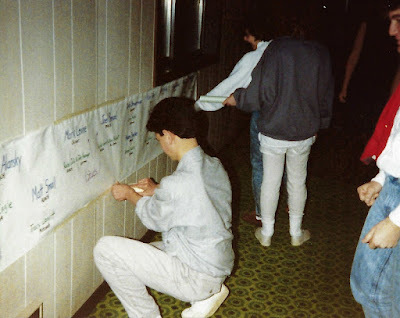
It wasn’t meant to be a dating app (and not just because apps hadn’t been invented yet). It was just a fun, fairly low-maintenance activity that could lead to a new friendship. We did it twice more, then passed the torch before graduating.
WHAT I LEARNED: the importance of trying to see situations from the perspective of other people so you can be as sensitive as possible to their feelings.
regional board
At spring convention of my sophomore year (the same at which the Late Valentine Match-Up debuted), Seth, Mike, and I ran for one of six main AZA regional board positions and won.
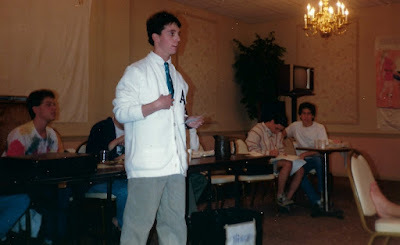 delivering my speech
delivering my speech
In the span of a year, I went from BBYO “hard pass” to “fast track.”
My position was Convention Coordinator, the only position with a non-Hebrew name. (Seth was S’gan, or Programming Vice President; Mike was Moreh, or Membership Vice President.) I proposed that my position be renamed Rakkaz, which is Hebrew for “coordinator.” (We spelled it with two Ks but now thanks to Google, I think it should be only one.)
The following spring, Seth won Godol (President) and Mike was reelected Moreh. I ran for S’gan…and lost.
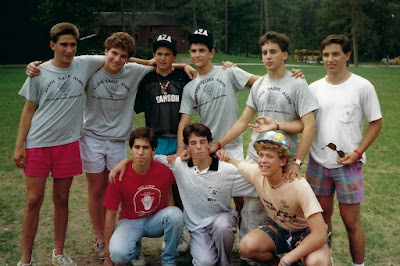 regional board my junior year
regional board my junior year
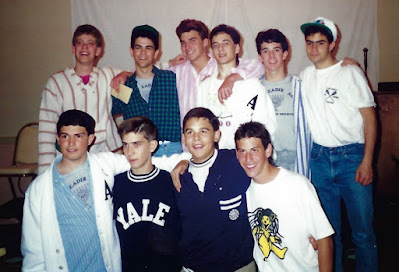 regional board my senior year
regional board my senior year
WHAT I LEARNED: how to give a campaign speech, how to live up to responsibility, how to lose gracefully.
“The Twilight Zone” convention
Convention Coordinators—sorry, Rakkazes—chose the theme for the convention they planned, and my co (BBG partner) Joy and I chose “The Twilight Zone.” (I was a huge fan of the show.) At age 16, I co-organized an entire weekend of programming for 265 kids.
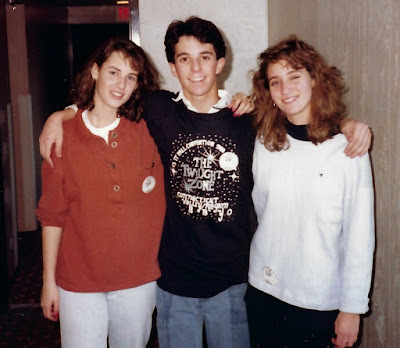 me sporting the convention T-shirt,which I designed, and two friends
me sporting the convention T-shirt,which I designed, and two friends
Highlights:
icebreaker combining a puzzle with the then-popular board game Scruples“Hands Across Convention,” inspired by (and much easier to organize than) the 1986 fundraising stunt Hands Across America a screening of/discussion about a Holocaust-themed Twilight Zone episode, “Deaths-Head Revisited”the first-ever professional group photograph of convention attendeesa “guess the baby photo” contest
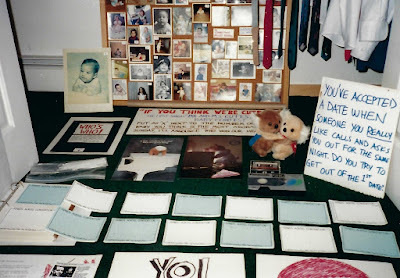 material for convention programs
material for convention programs
WHAT I LEARNED: how to juggle many balls at once, how to work with adults (booking speakers, etc.), how to host a huge party.
winning a character award
The spring of my junior year, I was surprised to win a regional award named for a former AZAer named Bruce Newman. Though I was immensely honored at the time, I could not remember who Bruce was (other than that he was before my time) or what exactly the award was for. I knew it was related to character. Unfortunately, I no longer have my award and you can barely see it in the photo.
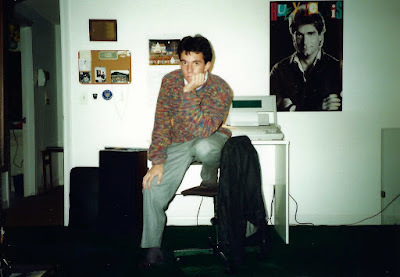 The award is hanging at top left; sorry about the sweater.
The award is hanging at top left; sorry about the sweater.
I reached out to the current CVR regional director who said that the award is still given out. Its purpose: to “memorialize the warmth, kindness and devotion that Bruce brought to CVR AZA and to recognize other young men whose love for the order and efforts on its behalf will keep the order strong and sustain it an eternity.”
WHAT I LEARNED: Kindness is its own reward, and sometimes this one, too.
Noar LeNoar
In this summer program, a delegation of about 15 BBYO members from other countries (Israel, France, Spain, and the United Kingdom were represented, and likely other countries I’m forgetting) tour several BBYO regions in America and individually stay for a few days with volunteer host families at each stop. I don’t think there was any organized programming; it was essentially a cultural exchange and free-form social experiment.
The summer after my sophomore year, my family didn’t host someone; the summer after my junior year, we were graced with the polite presence of a British boy named Jonny. I let him try driving our car—his first experience driving on the right side of the road (the opposite of England). I don’t even think he had his license yet! (It was only a small dead-end street. We survived.)
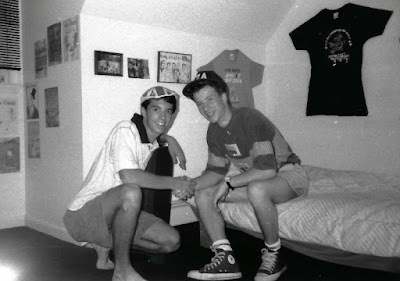
WHAT I LEARNED: International differences plus Jewish similarities makes for a fascinating friendship. Plus non-American girls are also cute.
worlds collide: BBYO and school
For my junior prom, I asked a girl I knew from BBYO. (She also asked me to one of her school dances.) For a formal BBYO dance during my senior year, I asked a girl I knew from school.
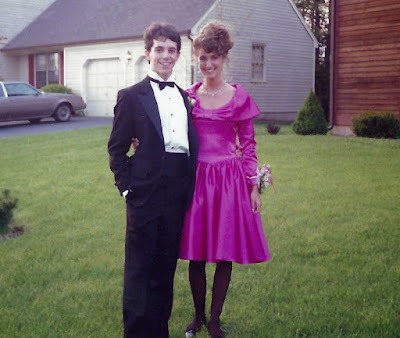
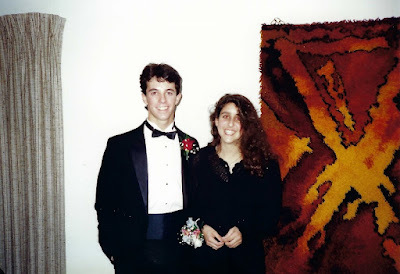
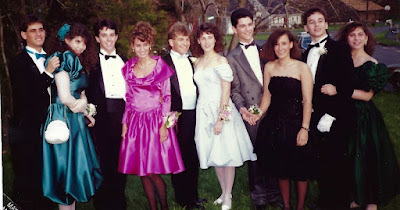 I was not the only one of my friends to bring a BBYOgirl to a school dance; Mike, Seth, Darren, and Kevin did, too.
I was not the only one of my friends to bring a BBYOgirl to a school dance; Mike, Seth, Darren, and Kevin did, too.
WHAT I LEARNED: the pleasure of exposing friends to new people and experiences.
Mazkir Pin-Up Page
My senior year, my regional board position was Mazkir—Secretary and Co-Editor of the regional newspaper, The CVR Connection.
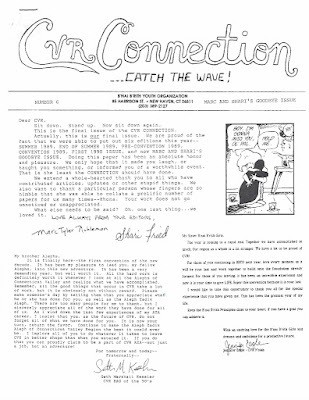
Each AZA chapter board also had a Mazkir, and I rallied them into a posse of sorts—something that wasn’t usually done. At events, we made some good-natured noise mostly for our own entertainment, and on occasion challenged groups of other board members to volleyball.
But the most prominent thing that came out of this silly side venture was the “Mazkir Pin-Up Page”—something we made, copied, and handed out…and something that no one asked for.
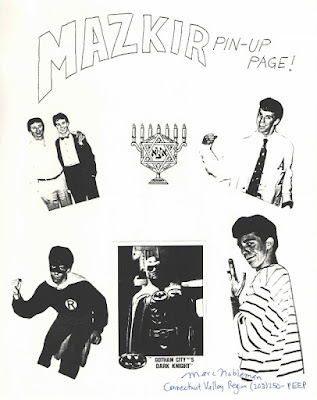 of course Batman makes an appearance
of course Batman makes an appearance
WHAT I LEARNED: nothing. It was just funny.
Biblical fact of the issue
Once, there was no internet. In those days, researching even basic information was more involved. As editor of the regional newspaper, I wanted to incorporate something both Jewish and historical/educational, so each issue, I shared a short fact about the Old Testament and the Bible in general. I wish I remembered the sources I used to compile those facts.
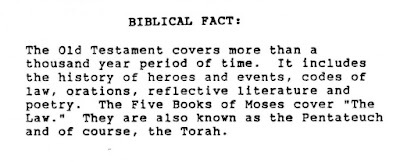
It was the kind of thing that most people wouldn’t think much about, and some probably didn’t even bother to read, but I was proud of it. In its own small way, it was a service, from Jew to Jew.
WHAT I LEARNED: facts about the Bible.
International Convention
In my BBYO era, International Convention (IC) was a weeklong summer event for several hundred BBYOers, held at a camp in Pennsylvania with the idyllic name Starlight. (Now it’s held during the school year, in a city hotel, and I’m told thousands attend.) I went to two ICs, the second being more seminal for me, for two reasons.
One, our region’s delegation of 20 boys was, at the time, the largest to ever attend IC. For the talent show, this group let me choreograph a performance piece to Paul Simon’s “You Can Call Me Al.”
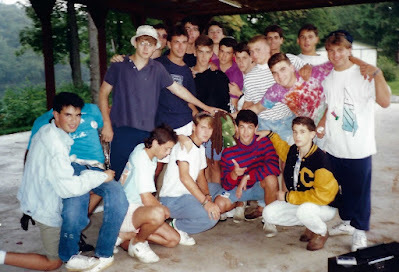
It was more than a lip sync. Because there were a lot of us, there was always more than one thing going on during the skit: I was flipping pages of a giant pad to reveal drawings that interpreted the lyrics, two guys were front and center mimicking Paul Simon and Chevy Chase from the music video, for some reason two other guys showed up as Saturday Night Live bodybuilder characters Hans and Franz, one or two acted like a dog (accompanying the lines “dogs in the moonlight” and “get these mutts away from me”), one guy was an air flutist, and we had a full air horns section.
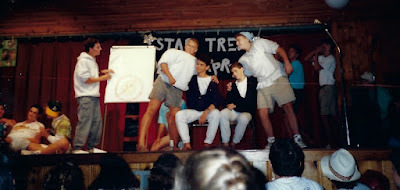
Was it high art? No. Did it put smiles on faces? Yes.
Two, one night, our big delegation got a little too spirited and the adult staff gave us a consequence for being disruptive: we had to choose between attending a popular event called Life in which the international leaders would recap their fondest BBYO memories or having a gathering of just our region for a more intimate session of soul-bearing. (Ordinarily, we’d be allowed to do both.)
Surprisingly, we were not all in agreement. I chose the latter—and eight others joined me. The other eleven chose to attend Life—and criticized me for opting not to. At the time, because we’d be punished, I felt it more important to debrief and reflect as a region than to listen to virtual strangers share stories that may not be as relevant to us. It put friendships to the test—for the first time, I was arguing with fellow leaders, and tears were shed. Because of that, it was a major growth moment for me. The next day, on the bus home, we all talked about what happened and made peace with it.
Not as seminal, but a fun crystal ball glimpse of my future: at some meeting, I passed around an idea for a program theme (which we called a “thrust”) I called “Project B.A.T.M.A.N.”—“Bringing Attention To Mass Anti-Semitism Now.” (This was 1989, the year of the first Tim Burton Batman film.) I was asking for input from fellow BBYOers from around the world.
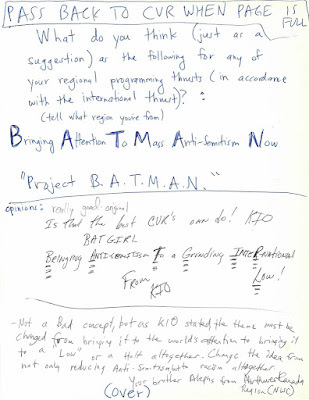 again with the Batman
again with the Batman
While I remain impressed that I was able to retrofit a relevant acronym to an existing superhero name, you can see that the first region to respond not only made a great point but also came up with another acronym for another superhero!
Also, for some reason, the boys used briefcases. But they did come in handy. How else do you expect us to transport our hacky sacks and dart guns?
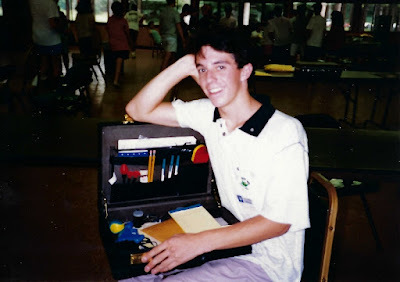
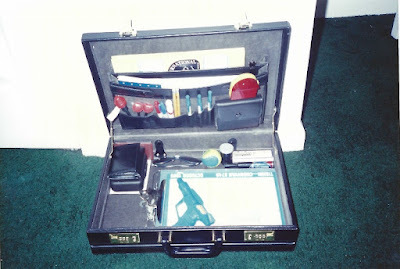
WHAT I LEARNED: how to stage-manage a big group at once, how to disagree constructively, how to move past uncomfortable situations.
notable figures in history
A lot of foundation-building happened at my last convention, spring of my senior year. I was part of a group that put on a thought piece, you might say, consisting of inspirational words from well-known people: Martin Luther King Jr., Franklin Delano Roosevelt, Neil Armstrong, Stephen Biko, and surely others I can’t recall. (Hopefully some women!) I portrayed FDR, Biko, and one of the astronauts. (All stretches, but it wasn’t about the acting.)
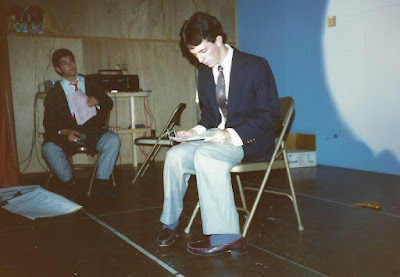 FDR
FDR
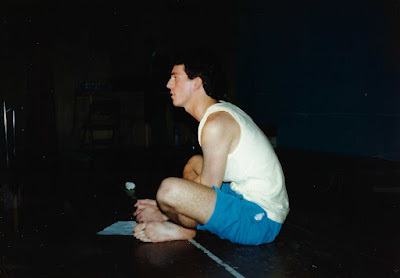 Biko
Biko
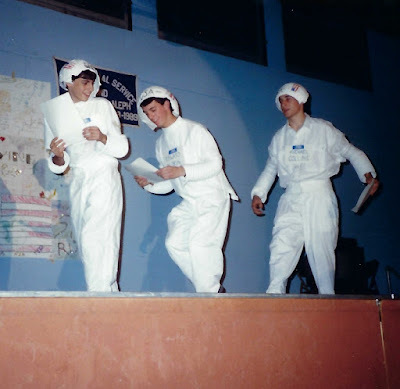 moonwalkers
moonwalkers
This program also included scripted bits from important human rights movements; Matt S. and I were in one about gay rights—quite progressive for teenagers in 1990!
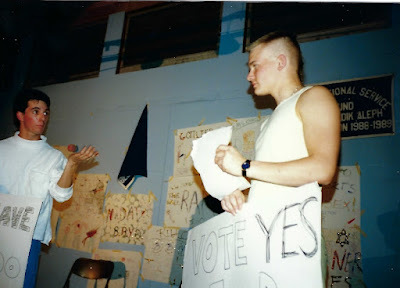
WHAT I LEARNED: how to distill key elements of big moments, the importance of doing what you can to support marginalized communities.
Ruach’s Greatest Skits
At every convention since fall of our sophomore year (so five times), my friends (now called the Ruach Six, even though we were technically seven) did a skit in the talent show—and to brag, ours were usually the best. We spoofed Star Trek and “Weekend Update” from Saturday Night Live; we added humorous flourishes to “Flash” by Queen and the theme from The Flintstones.
For our final talent show appearance, we did a greatest hits compilation called, appropriately, Ruach’s Greatest Skits. This means we redid all five previous concepts, but with new scripts for the Star Trek and SNL ones. By then, four of us had younger siblings who were also in BBYO, so we wrote a script for them in which they were remembering what their big brothers did in BBYO. This served as the framework for our skits—while the kid brothers and sisters were on stage “reminiscing,” we were backstage changing for the next skit.
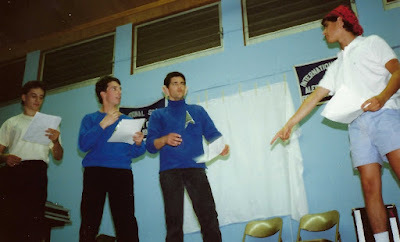 Star Trek
Star Trek
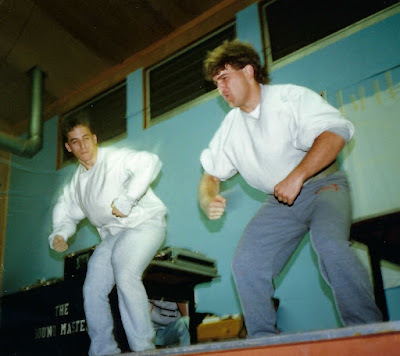 Hans and Franz again, as part of “Weekend Update”
Hans and Franz again, as part of “Weekend Update”
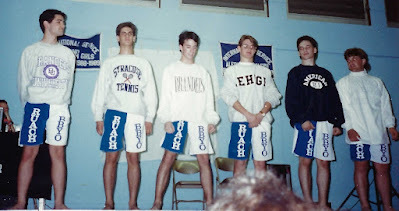 The Flintstones
The Flintstones
Here is the Flintstones routine:
Typically, a talent show skit would last only as long a song, but this took about 30 minutes! We didn’t tell that to the advisers in advance, and while it was happening no one shepherd’s-crooked us offstage. We felt we’d given so much to the organization and it was generous of the audience to give us this moment; then again, it was nostalgic for many of them, too.
For a bunch of teen boys who were not theater kids and had a lot going on because it was senior year, it was quite remarkable that we were able to pull off something this ambitious (with almost no meaningful rehearsal). It is one of my dearest memories not only from BBYO but from life.
WHAT I LEARNED: If you’re delivering something enjoyable, length doesn’t matter.
“Tell Us a Tale”
In BBYO, I debuted my “public” self by sitting on stage and singing, and that’s how I ended it. Only this time, no one—not even my closest friends—knew it was going to happen. After our Greatest Skits show, I performed a song set to Billy Joel’s “Piano Man.” It was meant to be a poignant tribute to my best friends and my time in BBYO, punctuated for inadvertent comic relief by some self-taught, out-of-tune harmonica.
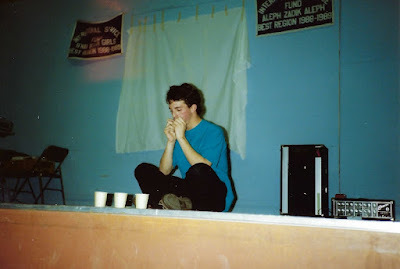
It was my first standing ovation.
WHAT I LEARNED: Whenever possible, make something good a surprise.
giving Life
As mentioned above, a BBYO tradition worldwide is the act of “giving Life.” It’s a graduating senior’s moment in the spotlight and last hurrah—the chance to speak about whatever you want in front of the assembled region. (There are time limits depending on your board positions.)
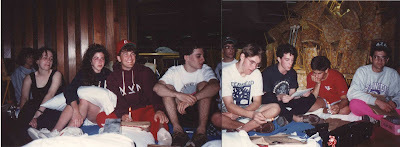 Kevin (red hat), Mike, Matt B., me (holding sheet), Darren (red shirt), Seth (pink pants)
Kevin (red hat), Mike, Matt B., me (holding sheet), Darren (red shirt), Seth (pink pants)
Usually everyone cries the whole time.
WHAT I LEARNED: Summarizing four densely scheduled and emotionally charged years in a few minutes is a worthy challenge for your mind and your heart. Also, saying goodbye even when you have a feeling you’ll see each other again can still be painful.
Up You Men
This is the official song/chant of AZA—or at least that’s how we considered it. Anyone can start it simply by shouting “Up you men!” It sets off a Pavlovian response from all AZAers within earshot—they will rush to you, form a circle, and jointly finish the song at the top of their lungs.
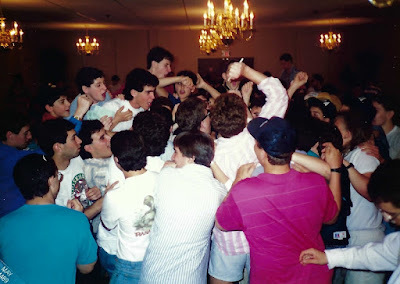
“Up You Men” is a real up-with-people experience—a bond of brothers that feels eternal.
WHAT I LEARNED: This song—and much else in BBYO—exemplifies the agency of both any one person and the group as a whole. You’re always part of something bigger—yet you always have a singular voice.
As an alum, I’ve had the privilege of speaking in part about my time in BBYO at several BBYO events…something I am able to do because of skills I began to hone in BBYO.
Oh, that guy Mike who hounded me for months to join BBYO? He’s still one of my best friends today.
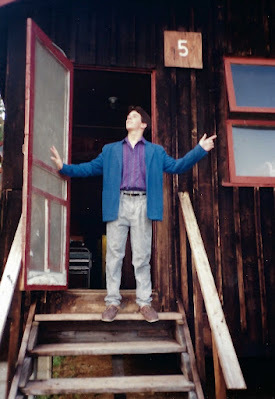 greeting the day in a great mood (and terrible outfit)at a BBYO event
greeting the day in a great mood (and terrible outfit)at a BBYO event
From 1987 to 1990, I was a proud member of the Connecticut Valley Region of the B’nai B’rith Youth Organization. It’s a mix of programming: social, community service, education, Judaic, and athletic. (I wasn’t much use for that last category.)
I also wasn’t a natural joiner. For the first half of our first year of high school, Mike, a guy I’d known since second grade and with whom I’d gone through Hebrew school hounded me for months, insisting I’d love it. Eventually I caved, thinking I’d prove him wrong. But soon I would be elected to a chapter board position for my sophomore year, and regional board positions for junior and senior year.
I owe him—and BBYO—a lot. I’m coming up on 50 and still regularly reflect on how in my teenage years, this experience was the most significant factor in my development.
Here are 20 of my most formative BBYO moments (in approximate chronological order). For each, I indicate what I learned; in some cases, it’s more accurate to say what was reinforced. The friends who feature most in these memories are the aforementioned Mike, Seth, Darren, Kevin, and two Matts (B. and S.).
Midnight Madness
This was a scavenger hunt spread across multiple towns in the New Haven, CT, area, so each team of four needed a car.
It took place at night. It was February of my freshman year. It was cold. I had no gloves or hat. I did not yet have my driver’s license (I was 15) nor did I carry a wallet. Of course no one had cell phones.
All of this made it even more distressing when the older boys on our team accidentally stranded Darren and me at a McDonald’s in a rough neighborhood. (They thought we’d left with another team; we were simply in the bathroom.)
After three nerve-racking hours, by chance, another team stopped by that restaurant and rescued us.
Oh, this was my first BBYO event.
I did not tell my parents till much later how wrong it went. Yet also right, or else I wouldn’t have returned for the next event. It’s the only entry on this list for which I have no photos.
WHAT I LEARNED: how to stay calm and be resourceful in a stressful situation.
The Ruach Rap-Up
My region, CVR, had about 14 chapters. Most were either all-male (AZA) or all-female (BBG). My chapter, Ruach, was one of only a couple that were coed. “Ruach” means “spirit” in Hebrew.

Each chapter would produce a newspaper for distribution at the marquee BBYO event, the regional convention (held twice a year over in a hotel for two nights). These papers would include recaps of events, humor pieces, essays, and other often ribald attempts to entertain the membership. Ours was called The Ruach Rap.
I decided to add a monthly one-page newsletter that would be mailed to each chapter member’s home—meaning it had to be less inappropriate than the newspapers because parents may see it first. I called it The Ruach Rap-Up.

 me with Matt S., my editor successor
me with Matt S., my editor successorWHAT I LEARNED: how to create something new, how to set and keep deadlines, how to delegate, how to edit.
helping the young, the sick, those experiencing homelessness
Self-explanatory!

 visiting a hospital on Christmas Eve;I have no idea what I am dressed as but it sure is festive
visiting a hospital on Christmas Eve;I have no idea what I am dressed as but it sure is festive donations we collected for people experiencing homelessness
donations we collected for people experiencing homelessnessWHAT I LEARNED: the imperative to give time to those less fortunate (or less old).
video to welcome new members
When I was still a new member myself, Mike, Seth, Darren, Matt B., and I made a well-intentioned but at times misguided video to introduce BBYO to new members. I don’t remember if we ever actually played it for any new members…but it was a blast to make.
WHAT I LEARNED: how to collaborate/compromise, a wee bit about film production.
“Bad” parody
At my second convention (fall of my sophomore year), I was pushed outside of my comfort zone for three minutes…and it changed the course of my life. The one pushing? Mike, the same kid who pushed me to join BBYO. (He was nothing if not consistent.)
Years before the child molestation accusations against Michael Jackson, and months before “Weird Al” Yankovic released the “Bad” parody song “Fat,” I wrote a “Bad” parody called…“Bad.”
In October 1987, I shared it with Mike and other friends at a chapter meeting. The next month, at fall convention, Mike urged me to sign up to sing it during the Saturday night talent show. As I did when he pushed me to try BBYO, I resisted at first. Then he said he and our other good friends would support me as “backup dancers.” (Never mind that most of them couldn’t dance.)
So I signed. And I sang. But I was so nervous that I sat the whole time. To my surprise (and relief), the audience loved it.

I ended up singing it publicly maybe a dozen more times over the next three years—at Sweet 16 parties (by request, for the video), at other conventions, even at my high school senior picnic. (Keep in mind my classmates had no idea that my geeky friends and I were cool every weekend in BBYO nor would they have pegged me as the kind of kid who would perform solo in front of a crowd.)
WHAT I LEARNED: how to overcome fear, how to trust a friend in taking a risk.
Beau-Sweetheart
The winter of my sophomore year, the region held its first annual Beau-Sweetheart Dance. We voted on a regional Beau and Sweetheart. Somehow I got on the ballot as the nominee from my chapter…and even more somehow, I won. I believe the criteria was “niceness” and maybe a little bit “cuteness.”

I’m still friends with Leigh, the Sweetheart.
WHAT I LEARNED: how to congratulate people you win against.
The Late Valentine Match-Up
Seth and I created a low-tech matchmaking questionnaire and solicited our region to fill it out. We revealed the matches at spring convention (which took place after Valentine’s Day, hence the name of the endeavor).

 We presented the results on a big banner.
We presented the results on a big banner.

It wasn’t meant to be a dating app (and not just because apps hadn’t been invented yet). It was just a fun, fairly low-maintenance activity that could lead to a new friendship. We did it twice more, then passed the torch before graduating.
WHAT I LEARNED: the importance of trying to see situations from the perspective of other people so you can be as sensitive as possible to their feelings.
regional board
At spring convention of my sophomore year (the same at which the Late Valentine Match-Up debuted), Seth, Mike, and I ran for one of six main AZA regional board positions and won.
 delivering my speech
delivering my speech In the span of a year, I went from BBYO “hard pass” to “fast track.”
My position was Convention Coordinator, the only position with a non-Hebrew name. (Seth was S’gan, or Programming Vice President; Mike was Moreh, or Membership Vice President.) I proposed that my position be renamed Rakkaz, which is Hebrew for “coordinator.” (We spelled it with two Ks but now thanks to Google, I think it should be only one.)
The following spring, Seth won Godol (President) and Mike was reelected Moreh. I ran for S’gan…and lost.
 regional board my junior year
regional board my junior year regional board my senior year
regional board my senior yearWHAT I LEARNED: how to give a campaign speech, how to live up to responsibility, how to lose gracefully.
“The Twilight Zone” convention
Convention Coordinators—sorry, Rakkazes—chose the theme for the convention they planned, and my co (BBG partner) Joy and I chose “The Twilight Zone.” (I was a huge fan of the show.) At age 16, I co-organized an entire weekend of programming for 265 kids.
 me sporting the convention T-shirt,which I designed, and two friends
me sporting the convention T-shirt,which I designed, and two friendsHighlights:
icebreaker combining a puzzle with the then-popular board game Scruples“Hands Across Convention,” inspired by (and much easier to organize than) the 1986 fundraising stunt Hands Across America a screening of/discussion about a Holocaust-themed Twilight Zone episode, “Deaths-Head Revisited”the first-ever professional group photograph of convention attendeesa “guess the baby photo” contest
 material for convention programs
material for convention programsWHAT I LEARNED: how to juggle many balls at once, how to work with adults (booking speakers, etc.), how to host a huge party.
winning a character award
The spring of my junior year, I was surprised to win a regional award named for a former AZAer named Bruce Newman. Though I was immensely honored at the time, I could not remember who Bruce was (other than that he was before my time) or what exactly the award was for. I knew it was related to character. Unfortunately, I no longer have my award and you can barely see it in the photo.
 The award is hanging at top left; sorry about the sweater.
The award is hanging at top left; sorry about the sweater.I reached out to the current CVR regional director who said that the award is still given out. Its purpose: to “memorialize the warmth, kindness and devotion that Bruce brought to CVR AZA and to recognize other young men whose love for the order and efforts on its behalf will keep the order strong and sustain it an eternity.”
WHAT I LEARNED: Kindness is its own reward, and sometimes this one, too.
Noar LeNoar
In this summer program, a delegation of about 15 BBYO members from other countries (Israel, France, Spain, and the United Kingdom were represented, and likely other countries I’m forgetting) tour several BBYO regions in America and individually stay for a few days with volunteer host families at each stop. I don’t think there was any organized programming; it was essentially a cultural exchange and free-form social experiment.
The summer after my sophomore year, my family didn’t host someone; the summer after my junior year, we were graced with the polite presence of a British boy named Jonny. I let him try driving our car—his first experience driving on the right side of the road (the opposite of England). I don’t even think he had his license yet! (It was only a small dead-end street. We survived.)

WHAT I LEARNED: International differences plus Jewish similarities makes for a fascinating friendship. Plus non-American girls are also cute.
worlds collide: BBYO and school
For my junior prom, I asked a girl I knew from BBYO. (She also asked me to one of her school dances.) For a formal BBYO dance during my senior year, I asked a girl I knew from school.


 I was not the only one of my friends to bring a BBYOgirl to a school dance; Mike, Seth, Darren, and Kevin did, too.
I was not the only one of my friends to bring a BBYOgirl to a school dance; Mike, Seth, Darren, and Kevin did, too.WHAT I LEARNED: the pleasure of exposing friends to new people and experiences.
Mazkir Pin-Up Page
My senior year, my regional board position was Mazkir—Secretary and Co-Editor of the regional newspaper, The CVR Connection.

Each AZA chapter board also had a Mazkir, and I rallied them into a posse of sorts—something that wasn’t usually done. At events, we made some good-natured noise mostly for our own entertainment, and on occasion challenged groups of other board members to volleyball.
But the most prominent thing that came out of this silly side venture was the “Mazkir Pin-Up Page”—something we made, copied, and handed out…and something that no one asked for.
 of course Batman makes an appearance
of course Batman makes an appearanceWHAT I LEARNED: nothing. It was just funny.
Biblical fact of the issue
Once, there was no internet. In those days, researching even basic information was more involved. As editor of the regional newspaper, I wanted to incorporate something both Jewish and historical/educational, so each issue, I shared a short fact about the Old Testament and the Bible in general. I wish I remembered the sources I used to compile those facts.

It was the kind of thing that most people wouldn’t think much about, and some probably didn’t even bother to read, but I was proud of it. In its own small way, it was a service, from Jew to Jew.
WHAT I LEARNED: facts about the Bible.
International Convention
In my BBYO era, International Convention (IC) was a weeklong summer event for several hundred BBYOers, held at a camp in Pennsylvania with the idyllic name Starlight. (Now it’s held during the school year, in a city hotel, and I’m told thousands attend.) I went to two ICs, the second being more seminal for me, for two reasons.
One, our region’s delegation of 20 boys was, at the time, the largest to ever attend IC. For the talent show, this group let me choreograph a performance piece to Paul Simon’s “You Can Call Me Al.”

It was more than a lip sync. Because there were a lot of us, there was always more than one thing going on during the skit: I was flipping pages of a giant pad to reveal drawings that interpreted the lyrics, two guys were front and center mimicking Paul Simon and Chevy Chase from the music video, for some reason two other guys showed up as Saturday Night Live bodybuilder characters Hans and Franz, one or two acted like a dog (accompanying the lines “dogs in the moonlight” and “get these mutts away from me”), one guy was an air flutist, and we had a full air horns section.

Was it high art? No. Did it put smiles on faces? Yes.
Two, one night, our big delegation got a little too spirited and the adult staff gave us a consequence for being disruptive: we had to choose between attending a popular event called Life in which the international leaders would recap their fondest BBYO memories or having a gathering of just our region for a more intimate session of soul-bearing. (Ordinarily, we’d be allowed to do both.)
Surprisingly, we were not all in agreement. I chose the latter—and eight others joined me. The other eleven chose to attend Life—and criticized me for opting not to. At the time, because we’d be punished, I felt it more important to debrief and reflect as a region than to listen to virtual strangers share stories that may not be as relevant to us. It put friendships to the test—for the first time, I was arguing with fellow leaders, and tears were shed. Because of that, it was a major growth moment for me. The next day, on the bus home, we all talked about what happened and made peace with it.
Not as seminal, but a fun crystal ball glimpse of my future: at some meeting, I passed around an idea for a program theme (which we called a “thrust”) I called “Project B.A.T.M.A.N.”—“Bringing Attention To Mass Anti-Semitism Now.” (This was 1989, the year of the first Tim Burton Batman film.) I was asking for input from fellow BBYOers from around the world.
 again with the Batman
again with the BatmanWhile I remain impressed that I was able to retrofit a relevant acronym to an existing superhero name, you can see that the first region to respond not only made a great point but also came up with another acronym for another superhero!
Also, for some reason, the boys used briefcases. But they did come in handy. How else do you expect us to transport our hacky sacks and dart guns?


WHAT I LEARNED: how to stage-manage a big group at once, how to disagree constructively, how to move past uncomfortable situations.
notable figures in history
A lot of foundation-building happened at my last convention, spring of my senior year. I was part of a group that put on a thought piece, you might say, consisting of inspirational words from well-known people: Martin Luther King Jr., Franklin Delano Roosevelt, Neil Armstrong, Stephen Biko, and surely others I can’t recall. (Hopefully some women!) I portrayed FDR, Biko, and one of the astronauts. (All stretches, but it wasn’t about the acting.)
 FDR
FDR Biko
Biko moonwalkers
moonwalkersThis program also included scripted bits from important human rights movements; Matt S. and I were in one about gay rights—quite progressive for teenagers in 1990!

WHAT I LEARNED: how to distill key elements of big moments, the importance of doing what you can to support marginalized communities.
Ruach’s Greatest Skits
At every convention since fall of our sophomore year (so five times), my friends (now called the Ruach Six, even though we were technically seven) did a skit in the talent show—and to brag, ours were usually the best. We spoofed Star Trek and “Weekend Update” from Saturday Night Live; we added humorous flourishes to “Flash” by Queen and the theme from The Flintstones.
For our final talent show appearance, we did a greatest hits compilation called, appropriately, Ruach’s Greatest Skits. This means we redid all five previous concepts, but with new scripts for the Star Trek and SNL ones. By then, four of us had younger siblings who were also in BBYO, so we wrote a script for them in which they were remembering what their big brothers did in BBYO. This served as the framework for our skits—while the kid brothers and sisters were on stage “reminiscing,” we were backstage changing for the next skit.
 Star Trek
Star Trek Hans and Franz again, as part of “Weekend Update”
Hans and Franz again, as part of “Weekend Update” The Flintstones
The FlintstonesHere is the Flintstones routine:
Typically, a talent show skit would last only as long a song, but this took about 30 minutes! We didn’t tell that to the advisers in advance, and while it was happening no one shepherd’s-crooked us offstage. We felt we’d given so much to the organization and it was generous of the audience to give us this moment; then again, it was nostalgic for many of them, too.
For a bunch of teen boys who were not theater kids and had a lot going on because it was senior year, it was quite remarkable that we were able to pull off something this ambitious (with almost no meaningful rehearsal). It is one of my dearest memories not only from BBYO but from life.
WHAT I LEARNED: If you’re delivering something enjoyable, length doesn’t matter.
“Tell Us a Tale”
In BBYO, I debuted my “public” self by sitting on stage and singing, and that’s how I ended it. Only this time, no one—not even my closest friends—knew it was going to happen. After our Greatest Skits show, I performed a song set to Billy Joel’s “Piano Man.” It was meant to be a poignant tribute to my best friends and my time in BBYO, punctuated for inadvertent comic relief by some self-taught, out-of-tune harmonica.

It was my first standing ovation.
WHAT I LEARNED: Whenever possible, make something good a surprise.
giving Life
As mentioned above, a BBYO tradition worldwide is the act of “giving Life.” It’s a graduating senior’s moment in the spotlight and last hurrah—the chance to speak about whatever you want in front of the assembled region. (There are time limits depending on your board positions.)
 Kevin (red hat), Mike, Matt B., me (holding sheet), Darren (red shirt), Seth (pink pants)
Kevin (red hat), Mike, Matt B., me (holding sheet), Darren (red shirt), Seth (pink pants)Usually everyone cries the whole time.
WHAT I LEARNED: Summarizing four densely scheduled and emotionally charged years in a few minutes is a worthy challenge for your mind and your heart. Also, saying goodbye even when you have a feeling you’ll see each other again can still be painful.
Up You Men
This is the official song/chant of AZA—or at least that’s how we considered it. Anyone can start it simply by shouting “Up you men!” It sets off a Pavlovian response from all AZAers within earshot—they will rush to you, form a circle, and jointly finish the song at the top of their lungs.

“Up You Men” is a real up-with-people experience—a bond of brothers that feels eternal.
WHAT I LEARNED: This song—and much else in BBYO—exemplifies the agency of both any one person and the group as a whole. You’re always part of something bigger—yet you always have a singular voice.
As an alum, I’ve had the privilege of speaking in part about my time in BBYO at several BBYO events…something I am able to do because of skills I began to hone in BBYO.
Oh, that guy Mike who hounded me for months to join BBYO? He’s still one of my best friends today.
 greeting the day in a great mood (and terrible outfit)at a BBYO event
greeting the day in a great mood (and terrible outfit)at a BBYO event
Published on December 10, 2021 16:17
December 9, 2021
First paid in-person school visit since 3/12/20
If you'd told me after my Ohio school visit on March 12, 2020 (and after I'd spoken at schools for nearly 20 years) that the next time I'd step foot in a school would be December 9, 2021...
Technically, I have thus far done two other in-person school visits during the pandemic, both pro bono: one indoors at my daughter's school, one outdoors (and part of the #KidsNeedMentors program). And I've done plenty of virtual visits.
But today's was the first paid, indoors visit. It was a most welcome return to form, with masks (and a souped-up PowerPoint).
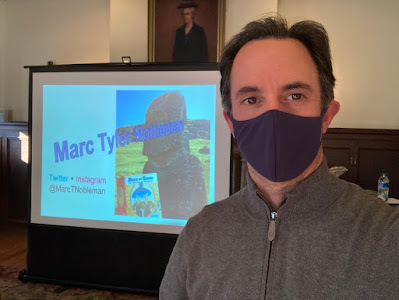
Thank you, Tatnall School in Wilmington, DE!
Technically, I have thus far done two other in-person school visits during the pandemic, both pro bono: one indoors at my daughter's school, one outdoors (and part of the #KidsNeedMentors program). And I've done plenty of virtual visits.
But today's was the first paid, indoors visit. It was a most welcome return to form, with masks (and a souped-up PowerPoint).

Thank you, Tatnall School in Wilmington, DE!
Published on December 09, 2021 18:07
November 5, 2021
“The Chupacabra Ate the Candelabra” StoryWalk in Michigan
It’s such a treat when an initiative I think is excellent collides with a book I happened to write.
The Chupacabra Ate the Candelabra is currently featured on a StoryWalk that the Caro Area District Library in Caro, MI installed in a nearby park.
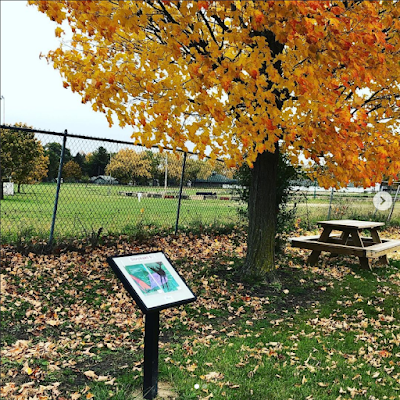
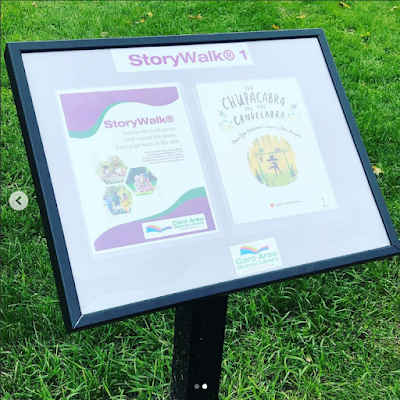
Thank you, Caro Library. Honored!
Combining reading and nature is win-win.
Photos courtesy of the library’s Instagram account.
The Chupacabra Ate the Candelabra is currently featured on a StoryWalk that the Caro Area District Library in Caro, MI installed in a nearby park.


Thank you, Caro Library. Honored!
Combining reading and nature is win-win.
Photos courtesy of the library’s Instagram account.
Published on November 05, 2021 09:13



